
Figure 1. Extra-terrestrial Alien Description Of Our Alphabet And Solar System.
Vedic Prophecies have long held that the Sun has a 'dark companion' and the
Bible Code, written about 3200 years ago not only contains references to it
(along with comet/asteroid impacts) but even refers to it by the name Vulcan. Madam
Blavatsky even refers to how its presence astrologically influences avatars
like Christ and Buddha. But there have been more recent references to this dark
companion, those from extra-terrestrial aliens sources. Dr. J. Allen Hynek (Astronomer)
seems to think that some of these alien contact reports were valid. Civilian scientific consultant to the U.S. Air Force (1948/49-1969) i.e. 20
years. He began as a debunker of UFO sightings, however he discovered there was
what he felt were a significant percentage of these reports which he could not
explain. He became convinced they deserved further study by the scientific
community.
Perhaps this was one that caught Hynek's attention.

A well circulated, but unpublished, case occurred on 6 Oct. 1974. The individual was invited on-board a saucer. Figure 1 is his description of their interpretation of our alphabet and a description of our solar system. Common human planetary symbols were employed by the aliens, but they may have been deduced years before. The first three alien symbols (12 V) translates to G2V. The Sun's recognized astronomical characterization is that of a G2 main sequence spectral class (V) star.
Three other solar objects are indicated, one above and one below the string of planets and a final one at the end. Two (* and phi) appear out of the ecliptic plane. One of these may be Eris whose inclined orbit indicates that it (and 2000 CR105) are 'captured' objects. The I symbol denotes a super-giant star, but if the Invitee failed to notice a V (i.e. VI) a sub-dwarf star is indicated (incorrectly associated with brown dwarf stars, but perhaps the only designation available to the aliens). The Invitee was told that the asteroids (Maldek) resulted from an exploded planet, a view since popularized by a Naval Observatory astronomer.
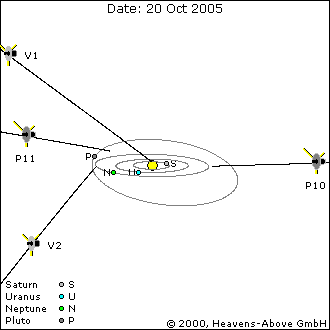
Figure 2 shows that the Voyager probes (launched 1977) bracket an object (a Brown Dwarf?) roughly located by the Pioneer probes (launched 1972 - 73). See Figure 3. Table 1 shows one of the first reported IRAS (Infrared Astronomical Survey) Satellite objects, IRAS 1732+239, in this direction.
| Probe/Target | Rt. Asc. | Dec. | Range | Helio. Long. | Helio. Dec. |
|---|---|---|---|---|---|
| Pioneer 10 | 5.057 hrs | 25.83 deg. | 89 AU | 77.20 deg. | 3.01 deg. |
| Pioneer 11 | 18.596 hrs | -8.57 deg. | 70 AU | 279.06 deg. | 14.59 deg. |
| Voyager 1 | 17.076 hrs | 12.13 deg. | 97 AU | 253.35 deg. | 34.78 deg. |
| IRAS 1732+239 | 17.5476 hrs | 23.9433 deg. | 448** AU | 260.78 deg. | 47.17 deg. |
| Voyager 2 | 19.680 hrs | -52.26 deg. | 78 AU | 287.50 deg. | -30.35 deg. |


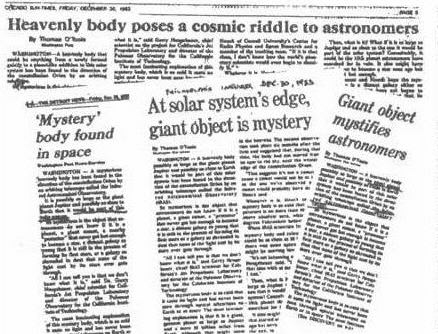
Figure 4. 1982 - 1983 NEWS Reports A Jovian Sized Object Discovered 50 Billion Miles Away.
| Object | RA (hr:':") | Decl.(deg.:':") | Uncert. | 60 žm/100 žm Flux (Jy/Jy/T/K deg.) | Discrip. | ||
|---|---|---|---|---|---|---|---|
| 0358+223 | 03:58:02.8 | 22:18:00 | 84"X30" | 0.68/1.5/44 | Dis. Galx. | ||
| 0404+101 | 04:04:44.7 | 10:11:52 | 66"X30" | 0.56/4.2/26 | Faint Galx. | ||
| 0412+085 | 04:12:32.3 | 08:31:13 | 38"X30" | 1.50/7.0/31 | Hot Cirrus | ||
| 0413+122 | 04:13:37.3 | 12:17:36 | 64"X30" | 2.20/3.4/55 | Triple Galx. | ||
| 0422+009 | 04:22:54.0 | 00:56:06 | 38"X30" | 0.68/3.0/31 | Poss. Galx. | ||
| 0425-012 | 04:25:21.1 | - 01;14;50 | 66"X30" | 0.75/2.0/39 | Galx. | ||
| 1703+049 | 17;03:01.4 | 04:57:50 | 100"X30" | 0.72/1.7/41 | Unknown | ||
| 1712+100 | 17:12:57.8 | 10:04:08 | 104"X30" | 0.65/1.9/37 | Unknown | ||
| 1732+239 | 17:32:51.4 | 23:56:36 | 78"X30" | 0.54/1.8/29 | Unknown (Vulcan?) |
| Parameter | Value | Max. Error | Min. 2 Sigma Error | Forbes'(1880) |
|---|---|---|---|---|
| Period (years) | 4969.0 | +30.4/- 24.3 | +/- 11.5 | 5000 |
| Orbital Eccentricity | 0.537 | +0.088/-0.035 | +/- 0.0085 | not cal. |
| Orbital Inclination | 48.44o | +3.12o/-9.05o | +/- 0.23o | 45o |
| Longitude of the Ascending Node | 189.0o | +/- 1.3o | +/- 1.3o | 185o |
| Argument Of Perihelion | 257.8o | +6.11o/-13.47o | +/- 0.90o | not cal. |
| Time of Aphelion (years) | 1970 AD | +/- 1.0 | +/- 1.0 | not cal. |
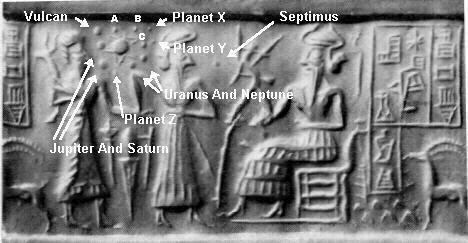
Figure 5 shows the Akkadian seal. Figure 6 shows a mathematical fit of the Sun and Jovian's diameters as measured from the 4500 year old Akkadian seal vs. their known masses. It clearly shows that the 'ancients' were aware of their relative size (by extra-terrestrial alien contact?). It also implies that there is another Jupiter like body in our solar system (our Vulcan), 141 +/-35 Earth masses in size. Similar size estimates for Vulcan can be deduced from actual TOI (time of perihelion) of the more definable comet clusters Vulcan generates (yielding a 0.05% Solar mass - 166 Earth mass - Vulcan) and from a suspected alien generated crop circle (yielding about two thirds of the original 0.105% solar mass estimate or 237 Earth masses.
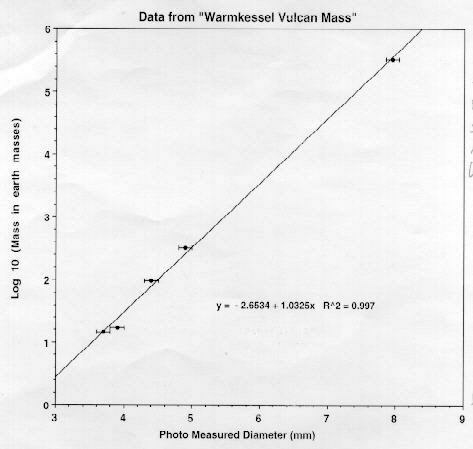
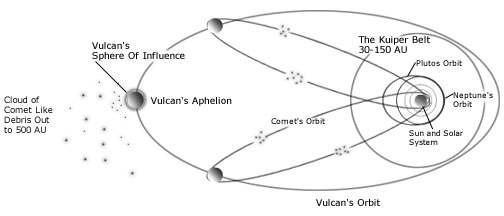
Table 4 illustrates that Earth has been the victim of many impacts in the recent past. Major comet/meteorite impacts cause significant weather changes and cause the collapse of civilizations. The most notable events are Noah's Great Flood (~3195 BC) and the Atlantis disaster (~9,703 BC). The comets/meteorites may not be visible until they hit the atmosphere as their volatile ices may have been cooked away during their many passes around the Sun.
Comet impact generated climate changes offer indirect evidence that verify Vulcan's theoretical period when the 3:2 resonance effect is considered. An interval of two theoretical Vulcan (4969 year) periods is required to maintain the same celestial geometry otherwise Vulcan's gravitational force slightly changes the comet swarm's period. The 9938 year interval has been measured to be accurate to within a year for two A Swarm Cluster 1 (A:Cl-1) impact events spaced two Vulcan periods apart. The measured value was found to be exactly 9939 +/- 20 years. However, the second event was a minor one as the major bolloid appears to have hit during the earlier event. A similar value of 9919 +/- 32 years is measured for the B:Cl-2 cluster that initiated the Younger Dryas period.
Indirect evidence is also available from giant comet 2000 CR105's average orbital period. CR105 is a member of the exclusive Extended Scattered Disk club containing only a few distant objects whose perihelion's are too far away from Neptune to be influenced by it. Unlike the Earth threatening comets, CR105 is a virgin comet whose motion is never influenced by the known planets. CR105 offers the elusive astronomical evidence that reveals Vulcan's existence and this is tantamount to discovering Vulcan. Including Vulcan's mass and orbit in the solar system, CR105's average period is 3319.3 years (3316.7 years without Vulcan). Multiplying by 3/2 gives Vulcan's period of 4979.0 years, ten years off the theoretical 4969 year value. Moreover, other scatter disk objects, like 2001 FP185 (3433.7 years) and 2002 GB332 (3234.2 years), appear to be in a similar 3:2 resonance and 1999 DP8 (1246 years) in a 4:1 resonance with Vulcan.
It is statistically certain that these intervals/periods are in the predicted resonant relationship with Vulcan's orbital period. The probability that CR105's orbital period is associated with Vulcan's theoretical period in a resonate relationship is 77% - 83%. The same probability for the A:Cl-1 impact events is 97% and for the B:Cl-2 events is ~57%. The B Swarm clusters are multiple and a little confusing. Any probability > 40% means that the two physical quantities are related.
| Observed Date Years Ago# |
Swarm A, A' B, B' or C | Cluster Delta* |
Cluster Pre Post Aphelion ** | Event |
|---|---|---|---|---|
|
289, 320 510 | B':Cl-2 B':Cl-1 | 237 - 278 | - | Small Strikes 1680 - 1700 AD? Mahuika Crater, New Zealand tsunami 1422 or 43 |
|
882 1120 | C:Cl-2 C:Cl-1 | 238 | - | Water, China Strike Tree Ring Data 880 +/-5 AD |
| 1464 | A:Cl-2 | 300 | - | Dark Ages Start Two-stage event after Comet of 531 AD Exploded Near The Sun. |
| 1584 1764 | Volcanic A:Cl-1 | - | - 666 | Volcano Volcano or Comet dust |
| 2044 | Comet dust | - | - | Caesars Comet |
| 2207 2430 | A':Cl-2 A':Cl-1 | 223 | - | Volcano or Comet dust Volcano or Comet dust |
| 2785 to 2838
3159 | B:Cl-2 B:Cl-1 | 374 - 321 | 843 - 790 740 | Global Climatic Boundary Exodus?/Bronze Age Collapse |
| 3370 | Volcanic | - | - | Volcanic dust |
| 3582 | ? | - | - | Joshua Impact Event 1582 BC? |
| 3628
3899 | B':Cl-2 B':Cl-1 | 271 | - | Comet - Deucalion Flood Comet - ? |
| 4020 | Volcanic | - | - | Volcanic dust |
| 4195?
4344 - 54 | C:Cl-2? C:Cl-1 | 149 | - | Sodom/Gomorrah sulfur found - 2195 BC? Global Comet Event |
| 4772 | Volcanic | - | - | Volcanic dust |
| 5006
5195 5201 | A: Cl-2 A:Cl-1 | 189 -195 | ~ 544? | S. Africa Strike Noah's Flood |
| 5550
| A':Cl-2 | - | - | Oldest Societies 3500 - 3600 BC |
| 6370 | B | - | - | Tree Ring Data 4370 BC |
| 7000 | B':Cl-1 | - | - | Water Strike/Black Sea Flood |
| 7600 | C:Cl-1 | - | - | Cold Dry Period |
| 8060
8230 | A:Cl-2 A:Cl-1 | 170 | - | Volcanism/Mini Ice Age |
| 8550 | A':Cl-2 | - | - | Global Climate Change |
| 9350 | A': Cl-1 | - | - | Global Climate Change |
| 9797-9907
9946 | B:Cl-2? B:Cl-1 | - | - | Strikes/Volcanism - Five dates from Copenhagen; 7797 BC, 7812 BC, 7878 BC, 7907 BC, 7946 BC |
| 10350 | B':Cl-1 | - | - | End Of Last Ice Age |
| 10850 | C:Cl-2 | - | - | Global Climate Change |
| 11320
11703 | A Cl-2 A:Cl-1 | 383 | - | Younger Dryas Exit? exact ice core data. 9,703 BC Atlantis impact event, Younger Dryas Exit? |
| 12220 | A':Cl-? | - | - | Younger Dryas Event? |
| 12,729
13230 | B:Cl-2 B:Cl-1 | 501 | - | exact ice core 12,679 BP 13.18 kyr BP ( Bolling/Allerod) |
| 13650 | B'Cl-2 | - | - | Younger Dryas |
| 14235
14,700 | A:Cl-1 A:Cl-2 | 375? | - | Huge pulse of freshwater drained from continental ice sheets ice
core Goughs Cave (Cheddar) radiocarbon |
The climatic change data provided by the Center for Ice and Climate, offers data showing at least five major weather changes about ten thousand years ago.
Figure 8 contains an image of Crop Circle T367. Note that the planets depict a planetary positions that seem to relate to late February 2007 and that the Earth appears missing from its orbit seeming implying that it will be destroyed (impacted by one of the objects labeled 2 - 5; comets?).
It is interesting that in this crop circle, the Sun is offset from a cleared central region. The offset is in the opposite direction of IRAS 1732+239. Considering Vulcan to be near aphelion, 448 AU, simple mathematical projection implies it is about half the mass of Jupiter. Vulcan's high inclination is not alluded to here implying that this crop circle is to be considered a 'cartoon' and not a 'photograph' of the physical situation.
The threat
periods assume that the comet debris round the Sun before threatening Earth.
Notable fireball
activity/meteorite fall has been observed during the threatening thirteen day
long periods. This activity is thought to be precursor debris to the main
massive objects. The dates of concern are:
2010, 2011 AND
2012 THREAT LEVEL
